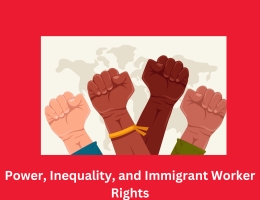
Racial Justice and Disability Rights
- By admin --
- Saturday, 13 Apr, 2024
HOW TWO MOVEMENTS WERE BIRTHED
The civil rights motion and the disability rights motion have a common purpose of achieving justice, equality, and inclusion for underrepresented organizations. The incapacity rights motion arose to sell the specific desires of those with impairments, encouraged via the advancements done through Black humans of their battle towards discrimination. Disability rights activists used techniques much like the civil rights motion, along with take a seat-ins, to protest the shortage of accessibility and unfair treatment of these with disabilities.
Disability Rights Michigan made the following commentary about the connection among the two actions: The disability rights motion and the following civil rights protections for people with disabilities could probable never have existed if it weren't for the civil rights movement. People with disabilities have been inspired to combat for complete prison inclusion and in opposition to segregation by way of the civil rights motion. People with disabilities had been regularly excluded or segregated via public institutions from employment opportunities, public education packages, and using public utilities like public transportation. They regarded to Black civil rights leaders, a lot of whom were also disabled, for steering on how to speak up for themselves.
Despite the truth that people with disabilities have long battled for rights and accessibility, the incapacity rights motion genuinely took off within the 1960s and Nineteen Seventies due to the fact to the strategies and thoughts of the civil rights movement of the Fifties and 1960s. Those who challenged the institutional boundaries that excluded people with disabilities thru civil disobedience, nonviolent protest, and collective action blanketed activists like Judy Heumann and Ed Roberts. They realized that the limitations encountered via those with disabilities had been not non-public problems, however as an alternative the result of institutionalized discrimination and environment designed with impairment in thoughts.
People with disabilities now revel in higher lives due to the fact to the primary successes the incapacity rights motion in the US completed. The maximum well-known example of this is the Americans with Disabilities Act (ADA), which was accredited in 1990 generally as a result of the movement's organizational and advocacy efforts. It is unlawful for corporations to discriminate against humans with disabilities in some of regions, including employment, public accommodations, telecommunications, public transit, and commercial dealings. Additionally, it hooked up new hints for accessibility, increasing inclusivity in public areas, systems, and services. Millions of Americans' lives were modified by the ADA, which continues to be a pillar of disability rights law and ensures equal rights and opportunities.
Another widespread turning factor within the marketing campaign was the 1999 Olmstead v. L.C. Supreme Court selection. The ruling of the Court upheld the entitlement of people with impairments to live in communal environments in preference to being needlessly institutionalized. It become a ancient ruling that highlighted the cost of network-based assistance and services as an opportunity to institutionalization and isolation. Most extensively, Olmstead reaffirmed the concept that individuals with disabilities are entitled to full inclusion in society and the help they need to stay unbiased lives.
UNSUNG BLACK DISABILITY RIGHTS MOVEMENT LEADERS People
coloration and other oppressed identities have been no longer usually covered within the disability rights movement, as turned into the case with other social justice organizations. Some activists in the Seventies fear[ed] that assertions of racial identity could divide human beings with disabilities from one another, in keeping with disability rights researcher and University of Richmond Professor Jennifer Erkulwater, which often resulted within the exclusion of individuals of groups of colour. Nevertheless, despite these barriers, a huge wide variety of Black activists contributed appreciably to the incapacity rights movement and are all too frequently not noted when discussing the records of disabilities.
Johnnie Lacy was a famous disability rights activist who turned into instrumental in the establishment of Berkeley, California's first Center for Independent Living (CIL). When Lacy sought to pursue speech remedy at San Francisco State University, she encountered discrimination since she became a wheelchair person who had reduced in size polio as a youngsters. Lacy fought for her rights and brought interest to the injustice of discrimination primarily based on her gender, colour, or handicap no matter the branch head's objections. Being a disabled Black girl, Lacy turned into shut out of numerous advocacy companies. She although persisted in her remedy to impart understanding and act as an notion, steadfastly selling an intersectional perspective on disability and racism, and devoting her professional life to the independent living motion.
In addition to taking element in the sit down-in, Lomax and Jackson organized their neighborhood to cook dinner warm meals for different demonstrators. They went to Washington, D.C. With different activists to place similarly stress on the defunct Department of Health, Education, and Welfare to release the regulations. Through their campaigning, the campaigners have been able to persuade the Carter management to enact these policies on April 28, 1977, giving handicapped people the much-wanted rights they deserve and permitting the anti-discrimination statute to have uniform enforcement methods.
Black impaired activists like Lacy, Lomax, and Jackson, among many others, had a long-lasting influence at the disability rights movement by using their activism, leadership, and creative achievements. Their dedication and tough work superior the dreams of equality and inclusion for handicapped human beings, contributed to create the field of incapacity rights, and promoted recognition and reputation.





